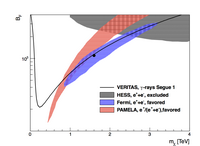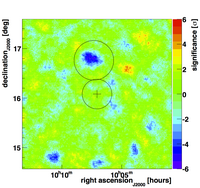The compelling evidence for the presence of non-baryonic dark matter in various structures of the Universe continues to motivate efforts to search for dark matter. Among many theoretical candidates for dark matter, Weakly Interacting Massive Particles (WIMPs) are the most popular and well-motivated. Candidates for WIMP dark matter are present in many extensions of the standard model of particle physics, such as supersymmetry (SUSY) or theories with extra dimensions. In such models, WIMPs can either decay or self-annihilate into standard model particles, which can produce a continuum of gamma-rays with energy up to the dark matter particle mass, or monoenergetic gamma-ray lines.
In this paper, the VERITAS collaboration reports on deep observations of the dwarf spheroidal galaxy (dSph) Segue 1, a very promising target for indirect dark matter searches. The dSphs are gravitationally bound objects that are believed to contain up to O(1000) times more mass in dark matter than in visible matter, making them widely discussed as potential targets for indirect dark matter detection. The VERITAS non-detection of the dSph Segue 1 is used to set constraints on various annihilating and decaying dark matter models. These constraints are among the best reported so far for any dSph observations in the very high energy gamma-ray band conducted by an array of imaging atmospheric Cherenkov telescopes (IACTs), and improve by at least a factor of 2 our previous limits derived from dSph osbervations. Furthermore, the VERITAS collaboration used the Segue 1 observations to address the dark matter interpretation of the cosmic-ray lepton anomalies reported by the balloon experiment ATIC and the satellite experiment PAMELA, and showed that such an interpretation was unlikely to explain these anomalies.
Figure 1: Significance map obtained from the VERITAS observations of Segue 1 after γ-ray selection and background subtraction. The black cross indicates the position of Segue 1. The black circles correspond to the two exclusion regions used for the background determination. See text for further details.
Figure 2: Left: dark matter annihilation/decay spectra for four different final state products (W+W−, Z0Z0, b-bar b and τ+τ−), extracted from PYTHIA 8.1 [87]. The spectra are plotted in the dN/dx representation, where x = E/m (or x = 2E/m for decay spectra). Right: 95% CL ULs on the integrated γ-ray flux above Emin = 300 GeV from the VERITAS observations of Segue 1 considering dark matter particle annihilation/decay for three different channels: W+W−, b-bar b and τ+τ−. For comparison, 0.5% of the integrated Crab Nebula flux above Emin = 300 GeV is 7.5 × 10−13 cm−2 s−1.

Figure 3: 95% CL ULs from the VERITAS observations of Segue 1 on the WIMP velocity-weighted annihilation cross-section <σv> as a function of the WIMP mass, considering different final state particles. The grey band area represents a range of generic values for the annihilation cross-section in the case of thermally produced dark matter. Left: hadronic channels W+W−, b-bar b and τ+τ−. Right: leptonic channels e+e− and μ+μ−.

Figure 4: 95% CL LLs from the VERITAS observations of Segue 1 on the decay lifetime as a function of the dark matter particle mass. Left: Bosonic dark matter decaying to two identical particles: W+W−, b-bar b, τ+τ−, e+e− and μ+μ−. The black star and the black cross denote the best fits to the Fermi and PAMELA data considering the μ+μ− and τ+τ− channels, respectively, and are taken from [58]. Right: Fermionic dark matter decaying to two different particles: W±ℓ∓ (where ℓ = e, μ, τ ) and Z0ν. The black triangle indicates the best fit to the Fermi and PAMELA data considering the channel W±μ∓, taken from [58].

Figure 5: 95% CL exclusion curves from the VERITAS observations of Segue 1 on <σv>/S as a function of the dark matter particle mass, in the framework of two models with a Sommerfeld enhancement. The expected Sommerfeld enhancement ¯S applied to the particular case of Segue 1 has been computed assuming a Maxwellian dark matter relative velocity distribution. The grey band area represents a range of generic values for the annihilation cross-section in the case of thermally produced dark matter. Left: model I with wino-like neutralino dark matter annihilating to a pair of W+W− bosons. Right: model II with a 250 MeV scalar particle decaying into either e+e− or μ+μ−. See text for further details.

Figure 6: 95% CL exclusion limits on the overall boost factor BF as a function of the dark matter particle mass from the VERITAS observations of Segue 1, assuming that the dark matter particles annihilate exclusively into μ+μ−. The shaded areas are the 2 σ contours derived from fits to the H.E.S.S., PAMELA and Fermi-Lat data. The black dot is an example of a model that simultaneously fits well the H.E.S.S., PAMELA, and Fermi-LAT data. See [99] for further details.







